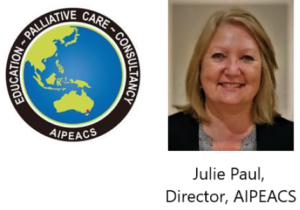
日本語訳監修: 木下佳代子 ジェックス参与
まずはじめに、3ヶ月ぶりに皆様にアップデートを送る事が出来て嬉しく思います。そして皆様やご家族の方々もお元気であったと
願っております。
今月は患者さんとの会話に注意深く耳を傾ける事により、入院している患者さんがどの様な不安を抱えているかを察知する方法に
ついて考えてみましょう。
次に紹介する「終末期における心の状態」と題された4分間の動画ビデオを視聴される事をお勧めします。
https://vimeo.com/528606847/a604b61e31 ( End of Life Essentials Program)
このビデオでは患者さんの不安を察知する事は難しいと述べておりますが、患者さんの不安には特定の兆候がある事を示しておりま
す。その患者さんの不安の兆候を察知する事は正しく支援するのに役立ちます。ある患者さんは特徴的なパニック状態を示しますが、
他の患者さんでは特徴的な状態を表わさず、死に対する不安を言葉にさえ表さない事もあります。
このビデオでは入院している患者さんの不安をどのように察知するかへのヒントを提供しています。このビデオでは患者さんは緊張
した時や緊張感を話す時に身体の振戦を感じると話していますが、これはうつ病の様な状態と違って不安症の可能性があります。患者
さんの話を傾聴して、不安のある患者さんによく見られる症状について考える事で、適切な援助ができます。大切な事は、すべての患
者さんは異なっており、症状も違います。患者さんは生涯を通じてすでにある不安を抱えて生きているのです。終末期の不安を経験し
た患者さんを思い出してみてください。
その時、患者さんの不安に気づきましたか?不安を考慮していない患者さんで緊張した時や緊張する話をした時に振るえると話す患
者さんを看護した事はありますか?患者さんが安心して自分の気持ちを話せる様に、私たちは患者さんと「適切な」会話をしています
か? 終末期の不安について考えるにあたって、臨床の場で何か異なる事を実践していますか?
ビデオの感想を聞かせて下さい。
もし何かご興味のある分野がありましたら、paulfamily59@bigpond.com までご連絡下さい。
来月のキャッチアップを楽しみにしております。
お元気で。ジュリー
事務局より:
ジュリーさんは、皆様からの感想、質問などをお待ちしています。
-
Disclaimer: June 2024 免責条項:
Julie’s Update シリーズ内の内容につき正確な情報の提供に細心の注意を注いでいますが、特にある事柄についての専門的意見を提供するものではありません。このシリーズに含まれる情報は、独立した専門家の見解に取って代るものではありません。また、医療上の助言として利用したり、何らかの疾患の治療、手当、又は、予防のために使用されるものではありません。
このシリーズにより提供される情報の利用、依存によるいかなる法的責任、怪我、紛失、損害については、責任は負いません 。
-
Julie’s Update: June 2024 (原文) -
Firstly, I am pleased to be back after a 3 month break and hope you and your families have been well.
-
This month we will focus on how we can identify when patients are anxious in the hospital setting by listening careful to the conversations they are having with us.
-
I encourage you to listen to this 4-minute animation video titled, State of Mind at End of Life Anxiety. https://vimeo.com/528606847/a604b61e31 ( End of Life Essentials Program). The video acknowledges that recognising anxiety in our patients can be challenging, however there are specific signs that can assist us in considering anxiety which will ensure the correct strategies are put in place to support the patient.
-
We know some patients describe specific episodes of panic, whilst other patients will be very non-specific and may not put their death anxiety into words. The video provides useful hints on how we can recognise anxiety in our patients in hospital.
-
The video reminds us when patients discuss feeling a tremor when uptight and/or discuss feelings of tension, that this is more likely to be anxiety as opposed to other conditions such as depression. By listening to our patients and thinking about common symptoms in patients with anxiety, we are more likely to ensure that the appropriate supports are put in place.
-
Remember our patients are all individual and as such will present differently. You may find they have a history of worrying which may suggest pre-existing anxiety throughout their life.
-
I would encourage you to think about the patients you have cared who have experienced end of life anxiety. Has anxiety been recognised? Have you cared for patients who describe a tremor when feeling uptight and or discuss feelings of tension where anxiety has not been considered? Do we have the “right” conversations with our patients to enable them to be comfortable in discussing how they are feeling?
-
In thinking about end of life anxiety now, is there anything you would do differently in your clinical practice?
-
I would be very interested to hear your thoughts on the video.
- If there are any particular areas you are interested in discussing further please let me know via email paulfamily59@bigpond.com .
-
Please note this is a new email address.
I am looking forward to our next month’s catch up. Take care Julie
